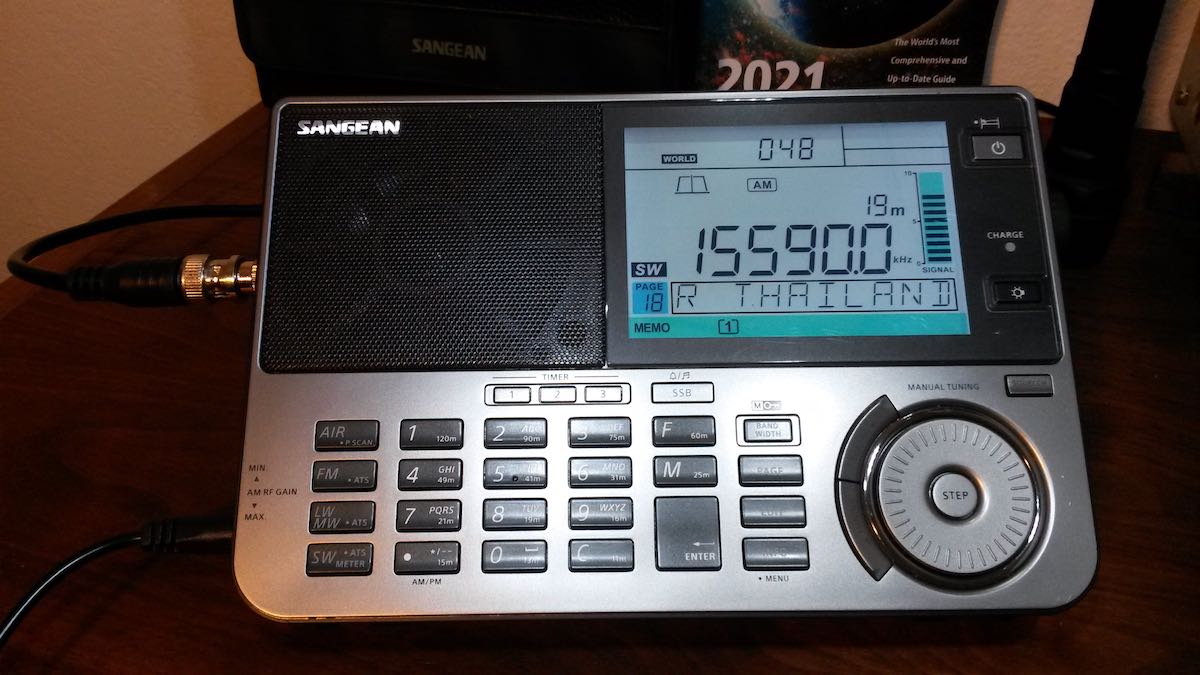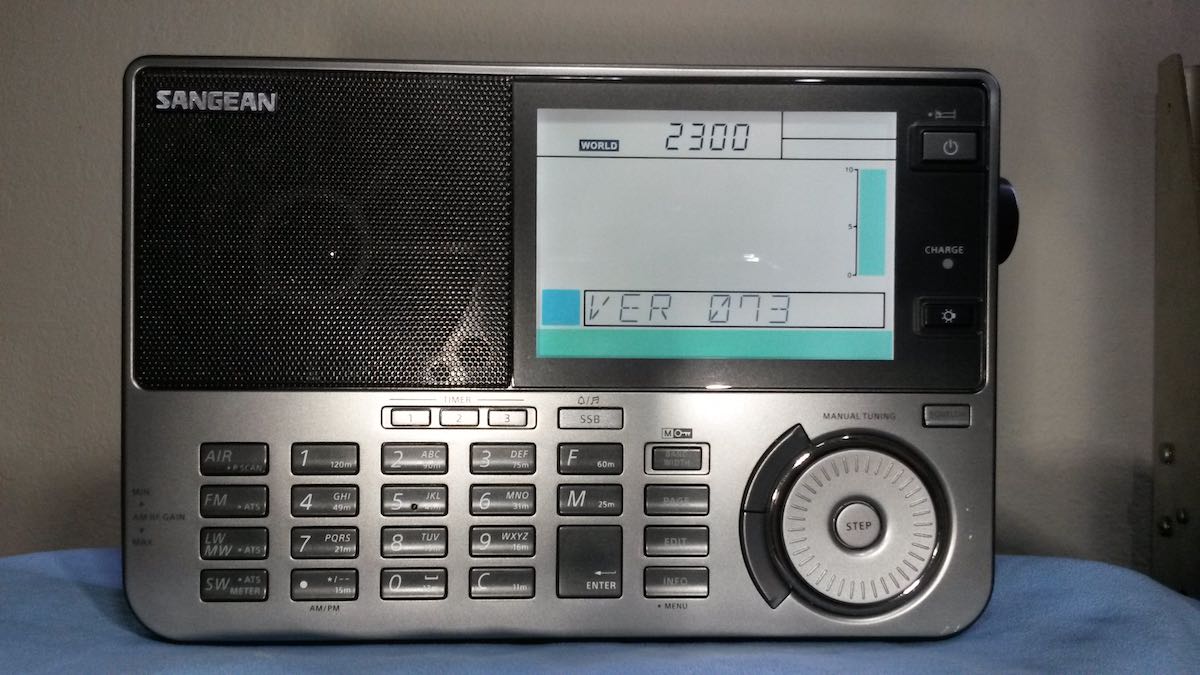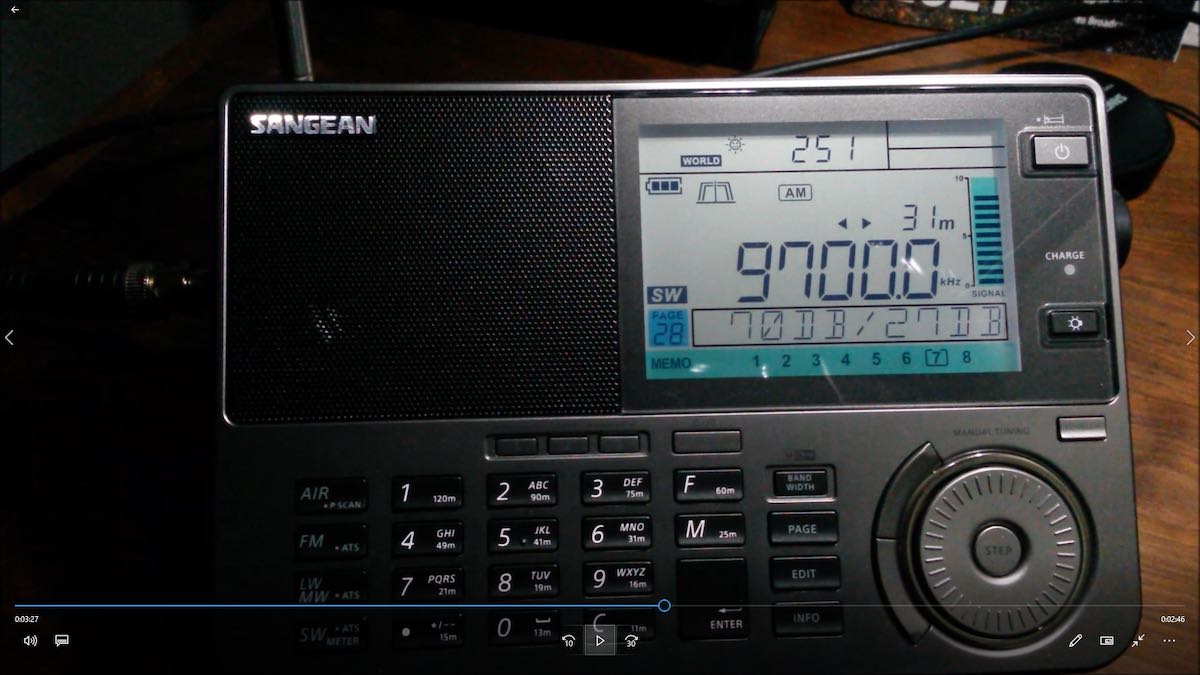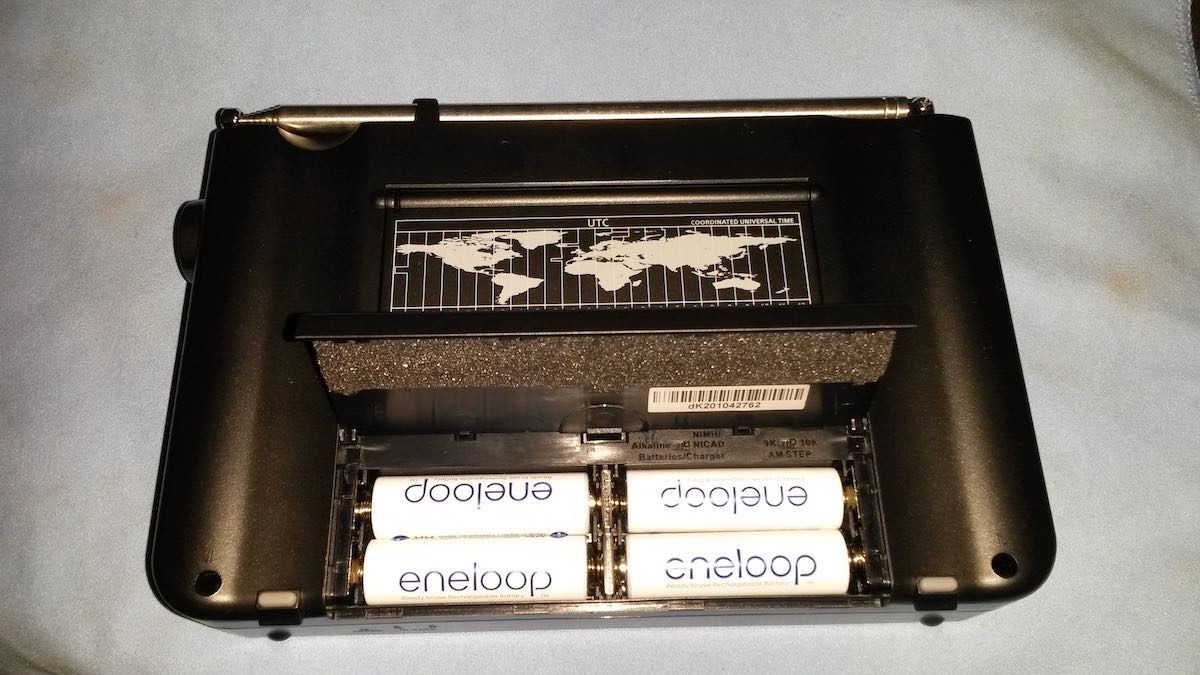Many thanks to SWLing Post contributor, DanH, who provides his final evaluation of the new Sangean ATS-909X2:
This should be the last update for my multi-part introduction to the new Sangean ATS-909X2. I am not expecting major new factory revisions or modifications for this fine radio. I received the 909X2 from Amazon on Sunday, February 21, 2021. This radio had VER 070 firmware installed. About a month later Sangean America offered a free upgrade to VER 073. I packed up my 909X2 and sent it away on March 29. My original radio with the original serial number was returned to me on Friday, April 9 following the firmware upgrade.
The 909X2 was away from home for eleven days but I had the 909X to keep me busy on shortwave. Time after time I reached for the new bandwidth controls on the older radio which were, of course, not there. This told me a good deal about how quickly I had become dependent upon some of the new 909X2 features.
As of this writing I have listened to the 909X2 VER 073 for several days. Let me tell you that in spite of my best efforts I could not find many differences between the two firmware versions. The later version was reported to correct some bugs encountered while using memory features. I can’t confirm this. I deliberately avoided making memory entries with my 909X2 VER 070 before I returned it as I understood that those presets would be lost with the firmware update. I gave the 909X2 memory a real workout last weekend but experienced no bugs during this mostly repetitive inputting session. More about that later.
One of the oddities of VER 070 firmware was a nice feature, actually. Cycling the INFO button would bring both radio signal strength (RSSI) and signal to noise ratio (SNR) up on the display at the same time. This feature was not described in the instruction book. With VER 073 you can toggle between one or the other but can’t see both at the same time. You can see this deleted feature below and watch it on my video:
I have tried to bring this feature up on VER 073 without success.
I found one small gremlin that seems to thrive on both 909X2 firmware versions. 909X2 indicates selection of fast or slow tuning rates by showing delta symbols on the display. Switching shortwave bands with the SW button followed by selecting a BAND button will result in a band change and disappearance of the delta symbols. Using the tuning STEP button will make the delta symbols return. Switching shortwave bands by using the “F” frequency button followed by number key entries and the ENTER button is slower for changing bands but does not cause the tuning step indicators to disappear.
909X2 charging and power supply design was much improved for the 909X2. 4xAA NiMH cells are individually charged and monitored. Charge times are faster, as well. The radio will identify cells that are defective, aging or wearing out. Each cell now has a separate slot in the battery bay. This contributes to longer battery life cycles, less waste heat production and improved rechargeable battery safety. This is a worthwhile but not very obvious upgrade from the 909X. The most noticeable outward change is the wider battery bay door.
Early production 909X wall wart power adapters are AC/AC center pin negative. Late 909X and 909X2 adapters are AC/DC center pin positive and feature in-line RF chokes. Both of my 909Xs contributed more RFI to shortwave reception when operated with AC power than the new 909X2. The upshot was that when I listened to shortwave at the desk with a 909X I would run it off batteries even if a wall outlet was handy for running AC power, much like any other multiband portable with shortwave. The 909X2 on AC power is so quiet that I usually have it on AC power when I have it at the desk. I can hear a little hum when using 909X2 under AC power when an external antenna and headphones (Sennheiser HD 280 Pro) are in use. I don’t hear this hum at all when using 909X2 speaker audio probably owing to the better bass response of my ‘phones. 909X2 will not initiate battery charging after every use. It charges only when needed. I now disconnect the 909X2 from AC power only when listening to shortwave with headphones or when using it as a cordless portable.
I have written earlier about the 909X2 MANUAL/AUTO bandwidth features. I normally use manual bandwidth filter selection for shortwave but with rough voice signals I sometimes find that 909X2 auto bandwidth plus the correct audio filter choice can do a better job than ECSS… and the 909X2 does ECSS and SSB very well. Auto bandwidth is excellent for less demanding conditions too, like keeping a radio tuned to a local MW or FM station that may fade lightly over the course of a day.
For FM the combination of great audio quality, RDS and now auto bandwidth makes the 909X2 hard to beat by any other multiband portable with shortwave.
The 909X2 is not my first radio with bandwidth filters provided by Silicon Labs DSP. I have long suspected that these filters are actually much wider than described by most manufacturers of portable multiband radios. The widest filter available for shortwave on 909X2 is identified as a 4 kHz bandwidth filter. This surprises me because the filter actually seems to accomplish attenuation somewhere between 3 and 4 kHz away from the carrier. This means the widest filter for shortwave is actually 6 to 8 kHz wide. This makes complete sense to me as to my ears this filter sounds closer to an 8 kHz bandwidth, which isn’t a bad choice for strong SW stations without interference.
I am an enthusiastic user of shortwave station memories. The 909X memory capacity is nearly too small for my current usage. The 909X2 has many more memory presets available and divides those into three memory banks. Something that many people did not understand about the ATS-909X is that when released in 2011 it never featured ATS for shortwave because it lacked the memory to do the job. Now, 909X2 memory banks may be reserved for favorite station pages or set aside for ATS scans.
Manual entry of shortwave pages and presets is relatively easy and fast on the 909X2 and is substantially unchanged from 909X. You may title pages alphanumerically any way you wish. 909X2 adds an additional feature: you may now change the position of a memory preset to another position on the same page or another page.
Setting up the new memory for the 909X2 took me the better part of an evening but good memory function is a huge advantage for anyone wanting to do shortwave station searches. There are many sample shortwave memory presets provided with the stock 909X2. If you enter your own pages and presets into 909X2 memory I suggest deleting all of the sample entries first (page names and presets) before starting your inputting. This will save you a great deal of time.
Each of my custom memory pages has a shortwave broadcaster name followed by a letter if I use more than one page for a single broadcaster. The 909X2 can scan preset frequencies on each page individually and land on the frequency with the strongest signal. If the location of saved station entries in specific memory banks isn’t sufficient deterrent for accidental erasure (like running an ATS scan on top of preset stations) the new 909X2 MEMORY LOCK feature will allow you to lock presets individually.
This may be the last update that I will post for the new Sangean ATS-909X2 but I will check the box at SWLing Post that allows me to see notifications of comment activity for this post for the foreseeable future. I’ll be happy to answer any questions regarding the Sangean ATS-909X2 addressed to me in the comments, if I can. For more 909X2 videos, see my YouTube channel at: Willow Slough DX
I will be adding to these as the new shortwave season advances. Happy listening!
DanH
Thank you so much for sharing your final evaluation, Dan!
If you would like to read all of DanH’s notes and reviews of the Sangean ATS-909X2, click here.





It is now 2024 and I have bought the latest version of this radio. It’s called the ats-909×2. I have no idea what version this is. I just unpacked it but is there an easy way to tell the version number? I’m really excited to put this up against my hopped up 2010 radio which is pretty close to being a tabletop receiver very close to my Drake R8 with the right antenna and a little ways behind my Pereus SDR
Nice update, I have a few thoughts on this new receiver, its a massive upgrade over the original 909, and the 909X, neither of which were really capable of ecss reception, which is very important to myself. I would also remind everyone that the softer volumes in ssb has existed in every 909 iteration ever released, I found my sample 909X2 to be much improved in this regard over the other two, though still obviously exhibiting reduced volume in ssb.
I have also found the 909X2 to be a superb MW receiver, and it absolutely rocks in MW via ecss reception, superior to the Tecsun H501x and at least the equal of the PL-880 in that regard. I also would alert folks to the proper procedure for setting up your 909X2 for 10hz ssb tuning, I do this because many have complained that the frequency is off, or rather out of calibration in ssb, you need to enter into the menu and manually set the tuning to 10hz, otherwise it will by default fine tune at 20hz!
The latter I think explains much of the reports about out of calibration radios, properly set to 10hz you will see that the tuning wheel still will fine tune for 4-5 micro-clicks and maintain frequency, in other words its not out of calibration at all, its simply the nature of the tuning wheel detents…
I received my ATS-909X2 VER 73 a couple of days ago. I have the SSB volume problem on AM broadcast, but no so much on Shortwave. I don’t notice much difference going to LSB from AM using the same bandwidth settings. There is a definite difference when going to USB. This is when listening to an AM signal. I think if you could select different bandwidths on SSB, it might help with the problem. I don’ t know about AM broadcast band. The difference there is really bad. I have to go to almost max volume to use SSB.
Have you tried using using LSB for SSB on shortwave for the ham bands under 10 MHz? I found that SSB reception for shortwave is excellent with the Sangean ATS-909X2, whether using LSB or USB for ham, utility or military signals. Some recent reviews completely fail to evaluate 909X2 SSB performance for SSB signals while stressing “ECSS” performance with standard AM signals instead.
I also found that using LSB or USB for standard dual sideband AM broadcast reception on shortwave (often called ECSS reception) can favor either or neither sideband using the 909X2. Try switching sidebands if one seems to offer unusually low audio response.
ECSS is often over-rated for reception of weak broadcast signals. If reception of a broadcast station is compromised by interference from a station 5 kHz or more away then it is best to utilize AM reception on portable radios rather than SSB. A combination of off-tuning by up to three or more kHz on the desired station sideband furthest away from the offending station in addition to IF bandwidth and audio tone adjustments usually works better than ECSS for skilled broadcast station DXers.
If a shortwave broadcast station is difficult to receive due to a weak signal then using LSB or USB is not guaranteed to improve reception. Sure, it may work sometimes but not always. I find that for a weak signal standard AM voice broadcast on MW or SW that Auto Bandwidth on the 909X2 along with the best audio filter selection is very hard to beat.
Oh wow, the lack of both signal strength and SNR is a real loss. I really wonder why they would remove such a useful feature from the radio.
These features are not lost on VER 073, rather they are not displayed together. One press of the INFO button with VER 073 will show signal strength, another press of the INFO button will show SNR, press gain and the active memory page and prest is shown and press a fourth time for the active memory bank.
Thanks for the amazing review. I have owned a 909×2 v070 since February. I use the joint RSSI/SNR display often so I think you’ve made up my mind as to whether I am going to send mine in for a firmware update. Its fast become my go to radio, even with the the volume level on SSB it seems to be more sensitive. than my Radio Labs 909x , and it doesn’t suffer the signal image problems my PL-990x seems to have when its attached to my longwire. Its a fantastic radio!
I hear that. If you like the way VER 070 shows RSSI/SNR on the same line and the memory function works for you why not? Keep in mind that the 11-segment SS meter is always up on the display.
Regarding the bandwith on SW, where 4 kHz appears to be widest but on the other hand sounds like it’s close to 6-8 kHz according to Dan’s excellent review:
Could it be the same as the Belka DX (which I have), which also have highest bandwith on 4 kHz in any mode, but where SW/AM bandwith is the value x 2 (value is for each side of the carrier)?
Best regards, Michael from Denmark
It could be that the definition of AM bandwidth has been lost or forgotten in some segments of consumer electronics. I learned the classic definition of AM bandwidth by reading US military technical manuals for surplus communications gear of the 1950’s and ’60s. These defined AM bandwidth as the sum of the upper and lower AM sidebands. This seems to be the same definition of bandwidth that I have encountered with SDRs including Airspy, SDRPlay and the networked KiwiSDR. I don’t know why bandwidth filters for many radios equipped with the Silicon Labs DSP chip seem to be at odds with this convention.
And what about digital radio, DAB+ fot VHF band 3 ? and DRM for SW MW LW ? this is not today an universal receiver. I will not change my 909X for this one.
,..how favorably or not, does the Sangean Ats-909X2 compare to the Radio shack DX-440 or the Sony icf-2010 ….?
Sangean made many advances with their radios after the Sangean ATS- 803A (DX-440) was introduced over 30 years ago, so I world definitely go with the 909X2. I would not mind having a fully reconditioned ICF-2010 as a collector’s radio but seriously… for my listening purposes I’m very happy with the 909X2 as my portable daily driver. These radios had different price tags when new. The DX-440 was $199 in 1989. Adjusted for inflation that would be $425 today. The ICF-2010 had a significantly higher price tag so it’s not really fair to compare the two old radios. It looks like the ATS-909Xs will be selling in the mid to upper $200’s after prices settle down.
The sangean 909×2 is a way better radio than the realistic dx440 ……no comparison in my opinion. My 2 favorite radios right now are the sangean 909×2 and the old Panasonic rf-2900 I got off eBay ??
Thank you very much Dan for the comments.
About the performance of the telescopic antenna in SW, do you really hear any improvement? on the 909X and 909-X radiolabs. frankly, performance is poor compared to other portable receivers.
Thank you very much.
My early version 909X was purchased in April of 2015. I could never receive more shortwave stations on the Eton Grundig Edition Satellit whip than with this radio. The 909X would be stronger on some bands and the Eton stronger on other bands. I noticed a slight improvement in shortwave performance on the whip with my late version 909X purchased in August of 2020. My 909X2 was built in October of 2020 and has noticeably better performance on the shortwave whip than either 909X. I can’t say honestly that any of these radios will pick up weak shortwave stations that the other can’t on the whip. I have no experience with radios modified by Radio Labs. All of my Sangean radios are stock units. Note that I use my shortwave portables indoors with good outdoor antennas most of the time. I have been known to go fully portable outdoors with stock whip antennas and a DIY 20′ mag mount vertical antenna.
I read Dan’s evaluations with great interest. I really appreciate the very thorough treatment of all the features and issues. I was eagerly anticipating this release because I read it dealt with my main problems with the 909X, and Dan has confirmed this. However, the price tag makes me hesitate. A lot of really good radios and some excellent used tabletops can be had in the neighborhood of $400. None, probably, with ALL of this radio’s myriad features. It sure seems like the flagship of new shortwave portables.
I had to read it twice. Very nice.
I’ve have owned the Sangean ATS-909X2 for almost a month, ver 070. I find nothing wrong with this version. This radio has quickly became my go-to radio, over taking my Tecsun PL 990. I believe the sensitivity is excellent on the Sangean. There are two items I wish the Sangean had. First: I wish I could do a All-Bands ATS scan being able to save 50+ stations per page, which would be more than just 9 stations limitations per page the Sangean ATS-909X2 has. Second: I wish the volume knob had a gripping texture instead of a smooth finish. A metal knob with a gripping texture would be nice. Besides these two items, I love the ATS-908X2. It became my daily use shortwave radio very quickly.